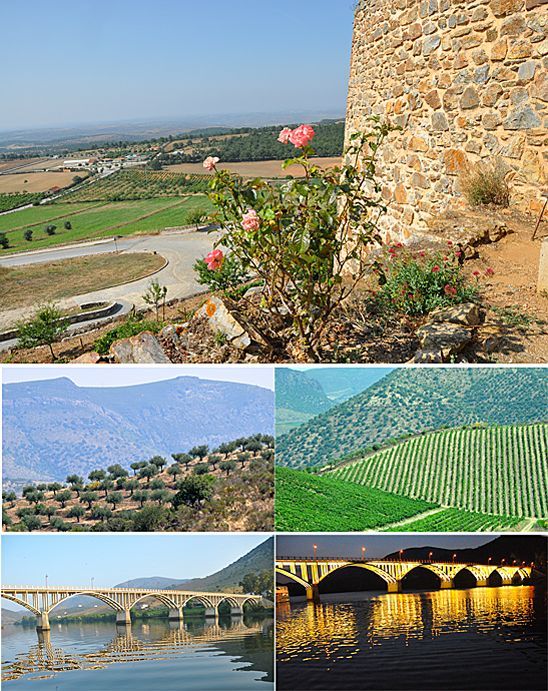Article
The Secret Portugal: Castelo Rodrigo, One of the Peninsula's Historical Hilltop Villages
Author(s):
Eric and Nancy Anderson travel to a place few tourists -- and few Portuguese -- have ever heard of.

Our boat’s captain, Pedro Sardo. Our location on the River Douro, close to Spain. Uniworld Cruise manager Luis Lopes.
Captain Pedro Sardo has brought the Uniworld Queen Isabel to Barca de Alva and our cruise manager, Luis Lopes, is about to tell us why. “We are,” he says, “about 20 miles from a place in Portugal that most Portuguese — far less tourists – have ever heard of. One of the historical hilltop villages of Portugal. This one is called Castelo Rodrigo.”
Luis’ ethnic background, like many of those here in the north of Portugal, is Celt, Roman and Jew. “Jews,” he says, “were the only group to arrive in this area without military conquest. They came before the Romans and during them. When the Moors conquered the Iberian Peninsula and settled here the Jews saw the Arabs as similarly educated.”
The Moors initially and for a long time were considerate about a person’s religion. Then the Moors were expelled and Spain issued a decree in 1492 in Salamanca requiring Jews to wear yellow cloth to show their religion. “It was the first sign of religious discrimination in Spain,” says Luis, “And Jewish people left in a hurry. Many came to those remote hilltop villages on the Portuguese border — it was “Jews on the Run.’ Many Jewish families adopted safe surnames: trees, towns, animals, jobs, guilds.”
The Spanish inquisition came to Portugal in 1496, 2 years before the discovery of the sea route to India by Vasco da Gama. “It was not only the Jews who were persecuted,” says Luis. “No other religion save Catholicism was allowed!” He muses about the situation today: “Now in Portugal we have a census every 10 years. Forbidden subjects in our census -- I say, proudly — include skin color and religion.”

We have passed through 5 locks so far as we ascended the Douro. Now we will climb by coach more quickly upcountry into one of Portugal’s hills, one actually on the border with Spain.
It’s a long story, as most historical tales are, and Luis continues it on the brief coach journey the next morning.
The hilltop villages have lost most of their populations and seem today peaceful — even serene – but they have been the scene of many battles as the aristocracy fought over ownership of their domains. In one campaign Castelo Rodrigo fought on the wrong side and later was required to wear its coat of arms with the crown upside down. “History is,” indeed, “written by the winners.”

The ruined castle seen in the distance — and closer. A church. Humans were shorter then, as this door shows, although doors were often made small to create difficulty for invaders on horseback. The cistern showing the Moorish influence on architecture.

For centuries people of different religions lived here peaceably under the Moors. The wall of one home displaying a cross shows the owner was Christian (Top); another wall below its window shows a faded Jewish cross (middle) and even now flowers grow in peaceful harmony on the village walls.

Although there’s not much activity in the village, it is a working village and it does have occupants who are at peace with themselves and their few visitors.

A great place for those who love the Scottish thistle and for those who are vegetarians.

Ruined homes and new construction with lots of uphill walking. Lots of irregular cobbles, too. Neighbors enjoy the distraction of the day, a chat. The village cat gives us the eye. Great views.
On our return to our river boat we pass the mixture of trees that can handle this arid countryside: Chestnut and almond trees, eucalyptus, cork oaks that lose their bark every 12 years and olive trees (Portugal is the fifth-largest olive oil consumer in the world). “There are olive trees in Majorca,” says Luis, “that are 2000 years old and like humans they get wrinkled over the years but their oil is used to prevent wrinkles in humans!”

The hilltop villages were almost impregnable as occupants could see any enemy approaching. Olive trees and vines standing like soldiers on parade. The welcome bridge over the Douro tells us we are home.
The Andersons, who live in San Diego, are the resident travel & cruise columnists for Physician's Money Digest. Nancy is a former nursing educator, Eric a retired MD. The one-time president of the NH Academy of Family Physicians. Eric is the only physician in the Society of American Travel Writers. He has also written five books, the last called The Man Who Cried Orange: Stories from a Doctor's Life.




